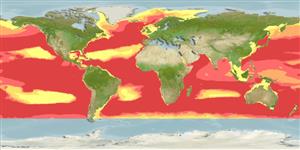>
Lophiiformes (Anglerfishes) >
Ceratiidae (Warty Seadevils)
Etymology: Cryptopsaras: Greek, kryptos =secret, hidden + Greek, psaras = fisherman (referring to this genus' tiny illicial bone, almost entirely covered by tissue of the esca) (Ref. 86949); couesii: Named for the eminent ornithologist Elliot Coues (Ref. 4525).
More on author: Gill.
Environment: milieu / climate zone / depth range / distribution range
Ecología
marino batipelágico; rango de profundidad 0 - 3085 m (Ref. 58018), usually 500 - 1250 m (Ref. 36494). Deep-water; 81°N - 52°S, 180°W - 180°E
Circumglobal: tropical and subtropical.
Tamaño / Peso / Age
Maturity: Lm ? range ? - ? cm
Max length : 7.3 cm TL macho / no sexado; (Ref. 4494); 44.0 cm TL (female)
Espinas dorsales (total): 1; Radios blandos dorsales (total): 4-5; Espinas anales 0; Radios blandos anales: 4; Vértebra: 20. A large median and two small lateral oval caruncles immediately in front of origin of dorsal fin (Ref. 13608). Branchiostegal rays: 6 (Ref. 36494).
Males dwarfed, becoming parasitic on females. Maximum size of free-living males is 1.05 cm (Ref. 4494). Females are oviparous, with planktonic larvae (Ref. 36494). Eggs are presumably contained in floating gelatinous rafts (Ref. 36494 ).
Life cycle and mating behavior
Madurez | Reproducción | Puesta | Huevos | Fecundidad | Larva
Females are oviparous, males are parasitic (Ref. 36494).
Bertelsen, E., 1990. Ceratiidae. p. 510-512. In J.C. Quero, J.C. Hureau, C. Karrer, A. Post and L. Saldanha (eds.) Check-list of the fishes of the eastern tropical Atlantic (CLOFETA). JNICT, Lisbon; SEI, Paris; and UNESCO, Paris. Vol. 1. (Ref. 4494)
IUCN Red List Status (Ref. 130435)
Threat to humans
Harmless
Human uses
Pesquerías: sin interés
Más información
ReferenciasAcuiculturaPerfil de acuiculturaRazasGenéticaElectrophoresesheritabilidadEnfermedadesProcesamientoNutrientsMass conversion
Herramientas
Special reports
Download XML
Fuentes de Internet
Estimates based on models
Preferred temperature (Ref.
123201): 2.8 - 10.4, mean 5.6 °C (based on 2308 cells).
Phylogenetic diversity index (Ref.
82804): PD
50 = 1.0625 [Uniqueness, from 0.5 = low to 2.0 = high].
Bayesian length-weight: a=0.01995 (0.00906 - 0.04395), b=3.01 (2.83 - 3.19), in cm total length, based on all LWR estimates for this body shape (Ref.
93245).
Nivel trófico (Ref.
69278): 4.5 ±0.37 se; based on food items.
Resiliencia (Ref.
120179): Medio, población duplicada en un tiempo mínimo de 1.4-4.4 años (tm=5).
Fishing Vulnerability (Ref.
59153): Low to moderate vulnerability (34 of 100).
Nutrients (Ref.
124155): Calcium = 58.6 [14.3, 144.7] mg/100g; Iron = 0.355 [0.143, 1.175] mg/100g; Protein = 18.2 [15.4, 21.6] %; Omega3 = 0.237 [0.062, 0.895] g/100g; Selenium = 11.6 [2.7, 41.2] μg/100g; VitaminA = 71.7 [6.1, 833.4] μg/100g; Zinc = 0.655 [0.299, 1.447] mg/100g (wet weight);
